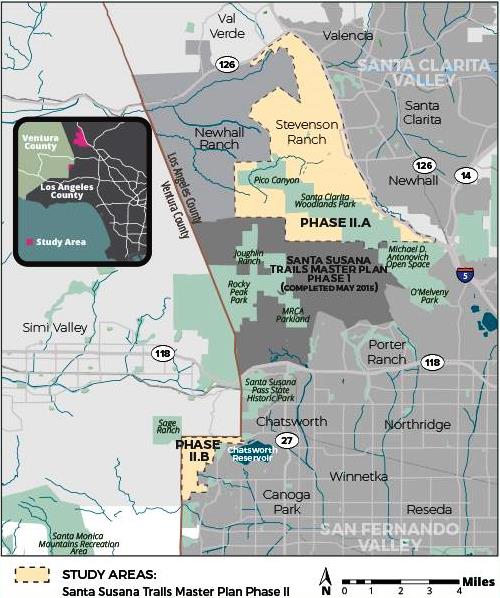
Fierce opposition forces Los Angeles County to drop planned paths to polluted Santa Susana Field Laboratory where contamination threatens humans and wildlife, including new cougar cubs
Bowing before public pressure, Los Angeles County announced on April 19 the termination of its plans to build hiking trails up to the grossly contaminated former Rocketdyne facility.
Sort of. At first, the County waffled and deferred to the controversial Department of Toxic Substances Control (DTSC) which oversees the cleanup of the Santa Susana Field Laboratory (SSFL). The agency has long been accused of the sabotaging of the overdue cleanup, resulting in continued risk to nearby communities. (See Until We’re Dead and Gone June 14 for the latest DTSC maneuvers and community outrage.)
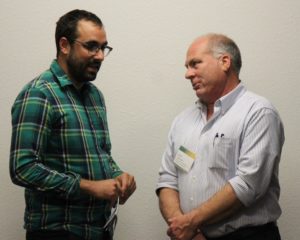
The County’s decision to defer to DTSC prompted an email from EnviroReporter.com. “What does that mean?” this reporter asked soon after Likins had issued the statement. “Do you mean when DTSC comes out with its EIR [Environmental Impact Report] later this year?” It makes little sense to delay a decision on trails only until DTSC has completed its EIR and decision-making process, as the site will still be contaminated and DTSC estimates that cleanup won’t be complete until 2034.
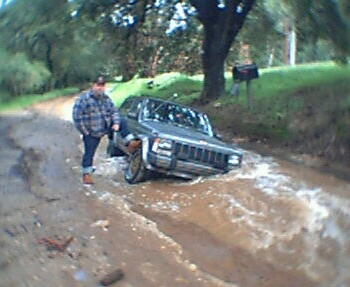
“Did LA County planners not know of these “environmental and health concerns” before releasing the Phase II.b plans and getting public input on them?” continued EnviroReporter.com‘s response to the Likin’s April 19 announcement. “Is LA County planning aware of the contamination shown to be in the Phase II.b area as evidenced in Toxic Trails and my comments on this issue?”
Likins didn’t respond to those questions, but he did amend the County statement on April 21 to make clear that indeed the trail plans near SSFL were terminated indefinitely. “The purpose of this letter is to update interested parties of the County’s determination to remove the Phase 11.b area from the Plan,” the letter said. “This change is the result of environmental and health concerns the County received during the public comment period for the Plan and MND [Mitigated Negative Declaration] related to the Santa Susana Field Laboratory (SSFL).”
The decision to nix hiking trails near SSFL is a public health victory. Sound science and community engagement won out over yet another attempt to greenwash Rocketdyne by declaring the place safe with no real cleanup. The County’s common sense will protect people from considerable hazards that may be in the dirt and dust downhill and east of SSFL in western L.A. County. The decision is also consistent with LA County’s longtime support of the SSFL cleanup agreements.
Sodium Reactor Experiment Pond
Of course, terminating toxic trails doesn’t remediate the poisoned place to which the paths would have led. Nor does it protect the wildlife at that polluted place, like the litter of four mountain lion cubs, and their mother, found and tagged at SSFL this spring. These beautiful beasts, as well as other creatures at the massive site, are endangered by the very environment they call home because of the huge amounts of contamination that exists in the soil, soil gas and water.
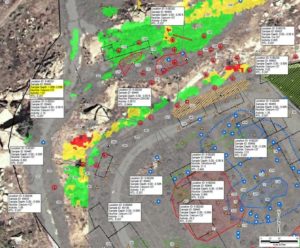
One area that wasn’t tested at that time, and remains a threat to the environment, humans and animals, is the Sodium Reactor Experiment (SRE) Pond. Averaging about six feet deep when filled, EnviroReporter.com has uncovered information that shows the SRE Pond has been contaminated with massive amounts of radiation, chemicals, heavy metals, dioxins and polyaromatic hydrocarbons (PAHs) at extremely high levels.
Yet even with this pollution, which the federal Department of Energy (DOE) is obliged to remediate to background levels of contamination, nothing will be done with the SRE Pond other than reclassify it as a “wetland.” This was revealed in the DOE wetlands assessment report, part of its January 2017 Draft Environmental Impact Statement for Remediation of Area IV and the Northern Buffer Zone of the Santa Susana Field Laboratory, Appendix I.
It’s an odd place for wetlands, but critters must certainly welcome the pond’s untested waters when thirsty. Indeed, the pond was the SRE’s down gradient drain for years.
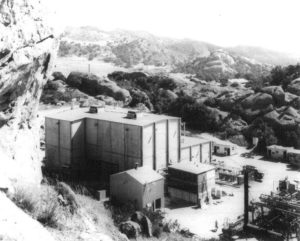
“The small impoundment below Outfall 4 is known as the SRE pond and is a man-made feature,” the DOE report says. “No digging was done in the SRE pond because of the potential to encounter contaminated soils.”
Say what? It’s not like the pond doesn’t dry out, making taking a few samples less onerous than all the ones taken at the actual site of the Sodium Reactor Experiment itself. The report shows the “pond” without water, making its exclusion from testing, excavating and remediating all the more incomprehensible. But rather than “encountering” the contamination that it created, DOE has instead relabeled the toxic pond as wetlands.
In 2010, DOE agreed with DTSC to remediate its entire site to background levels of radiation and chemicals. So did NASA. That cleanup should include the Sodium Reactor Experiment Pond, which drains down into the Jewish kids’ camp at Brandeis-Bardin during heavy rains as Google Maps show.
The SRE Pond is one of the water bodies that Boeing might be referring to in its Santa Susana web page when it notes all the animals “Around the Watering Hole.” This little known pond is definitely not one of the SSFL ponds Boeing or DOE is cleaning.
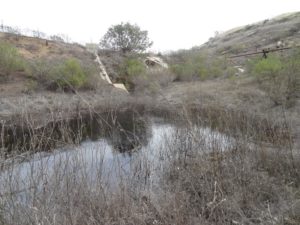
This isn’t the first time the SRE Pond was released for unrestricted use while it was likely grossly polluted. DOE’s predecessor, the Atomic Energy Commission, did just that on October 21, 1977. A subsequent Rockwell report showed the “SRE Pond Excavation” in August 1979, nearly two years after the place was released from controls. This excavation did not get all the goo.
“The SRE Facility is located upgradient in the drainage basin for the SRE pond,” said a 1990 Rocketdyne report. “The SRE was operated from 1957 to 1964. Storm water runoff has been the only source of water to the SRE pond since 1964. Materials used at SRE included enriched uranium and sodium.”
“Fourteen sediment samples were collected from the SRE pond” with the highest Cesium-137 radiation reading topping out at over 236 times the normal background (BTV) for it in Area IV later derived by the U.S. Environmental Protection Agency in 2012. According to documentation reported on by EnviroReporter.com, the California Highway Patrol considers any material or situation over 3.0 times background to be the triggering level for a hazardous materials incident. This reading is so hot it is 78.9 times the CHP Haz-Mat tripwire.
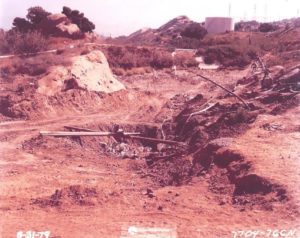
“Downstream areas from SRE pond which had releases both downstream and through effluent pipes to other areas must be further sampled on a much tighter grid leaving no areas without samples within this facility area,” the commenter wrote to DOE. “The delineating circles identified as North Slope Debris Areas A, B, and Storage Areas do not adequately define these areas and inadequate sampling has been shown for any determinations to be made here. Debris on this hillside has been observed by the writer to include a storage can (possibly 30 gallon size) with a very thick lid that could indicate radioactive material storage in the past and should be further reviewed and sampled for verification.”
Remarkably, the DOE agreed. “The commentor is correct that the effluent pipe discharge and drainage areas should be classified as Class 1 and will be included through the extension of the EU-01 Rad Class 1-02 survey unit boundary to encompass the discharge and drainage areas,” DOE responded. “At the commentor’s suggestion, DOE will change the classification of the North Slope Debris Area B and the North Slope Storage Area to Class 2.”
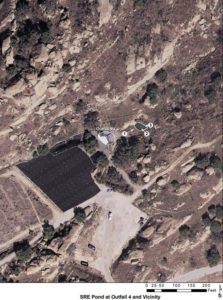
Analysis of the Area IV soil removal estimates in a September 4, 2013 letter to DOE from a subcontractor reveal massive amounts of contamination in the SRE Pond. Under a table called “Summary of Area IV Clearly Contaminated Areas,” the SRE Ponds is listed. “The chemical contamination area extent was based on sampling data and the limits of the pond,” the letter said meaning that the goo was everywhere they tested.
Four human carcinogens were found at astronomical levels in the pond’s dirt down to six inches deep. Benzo(a)pyrene was tested at 104.4 times its background threshold value and Benzo(a)anthracene was 206.9 times its BTV. Benzo(b)fluoranthene registered 206.9 its BTV and Indeno(1,2,3-cd)pyrene was nearly 240 times its background, also derived by the USEPA for Area IV chemicals in 2012.
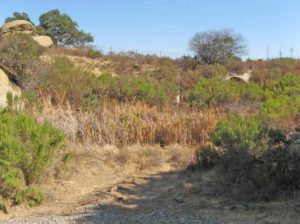
DOE doesn’t seem to have tested the water in its newly designated wetland pond but it stands to reason that if the pond bottom is riven with toxins, the water that collects there isn’t good for the wildlife. The cynical ploy to treat the SRE Pond as a wetland instead of digging it out may serve the greenwashing campaign to makeover SSFL as a wildlife refuge that doesn’t need cleanup, which would save the polluters millions. But the reality is that it induces wild beings to innocently drink from that poisoned pond and that is nothing less than an outrage.
Wildlife Already Endangered at SSFL
The Sodium Reactor Experiment Pond is within padding distance of the recently discovered SSFL mountain lion cave with four female cubs this spring. Those lion kittens, and their mother, could use the SRE Pond as a drinking source, which could potentially poison them or cause radiation-induced genetic mutation in the already inbred local lion population. The SRE Pond water has not been tested and is not fenced off and grated to keep critters out as Google Maps evidences quite clearly.
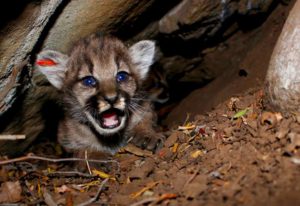
“Aroclor 1254, Aroclor 1260, and dioxins/furans contribute to unacceptable risk to the hermit thrush and deer mouse,” the report said for both soil and soil vapor. That’s in addition to the more famous gases fuming out belowground burrowers. “1,1-DCE and TCE in soil vapor contribute to unacceptable ecological risk to burrowing receptors.”
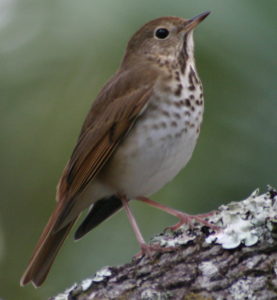
Boeing’s own subcontractors told it that SSFL dirt and soil gas threatened the hermit thrushes. Yet instead of addressing the problem and promising to remedy it, the company scheduled more public hikes and bus tours that stop at the former SRE site for a walkabout near the Sodium Reactor Experiment Pond. Lux bus tours and waiver-required hikes are easier – and cheaper – to hold than the down and dirty nitty gritty of digging out the SRE Pond’s toxic crud and making the land, and Brandeis-Bardin, safer for future generations. Not to mention the mountain lion cubs.
Due to Los Angeles County’s better late than never decision to deep-six Phase II.b trails, no walkabouts led by greenwashers will be built at taxpayer expense leading to a blighted site that is so toxic it harms the fauna according to the polluter’s own reports.
But until SSFL is cleaned up per agreements in place since 2010, neither wildlife nor humans will be protected from the hubris of polluters where greed trumps social responsibility.
25 Years of Award-Winning SSFL/Rocketdyne Reporting
1998 – 2023












Thank you Michael.
Stopping toxic trails in their tracks is not an easy feat as this exposé shows. Yet even with the polluters’ go-to greenwasher in the lead peddling these untested paths, media and public pressure still won the day through sound science and common sense. This is not the case in Colorado at the Rocky Flats National Wildlife Refuge which is about to open. An excellent Los Angeles Times article today tells the outrageous tale: The area around Rocky Flats nuclear plant may soon open to the public — and some say that’s a disaster in the making. It’s a terrific read but doesn’t have the relatively happy ending that “L.A. County Terminates Toxic Trails” has.
It’s a tribute to the people working for Los Angeles County that they seriously considered, and acted upon, detailed and compelling information that showed just how unwise building new trails in the Hot Zone could be. That said, the polluter-funded greenwashing campaign continues with hikes through the Southern Buffer Zone which has even more documented contamination problems than the now-nixed Phase II.b plan.
How much money did LA county blow on the stupid idea to trailblaze paths up to Rocketdyne? Thank you for stopping this stupid plan and caring about the animals that live there. That pond has to be made off limits.
Shocking new evidence supports EnviroReporter.com‘s contention in this exposé that the SRE Pond – and the rest of Area IV – are radioactive sites so poisonous that they can cause genetic mutations among the fauna like birds, rodents, insects and mountain lions. Indeed, we have already shown a mutated Ceanothus silk moth from SSFL presented in a Boeing calendar in 2016’s Critics question safety of Boeing’s Santa Susana Field Lab hikes. Now comes new evidence from a Swiss study of “true bugs” within 5 kilometers of 3 Swiss nuclear reactors showing that these critters have a highly significant twofold increase in morphological malformations, 2.1 times to be precise.
Morphological Abnormalities in True Bugs (Heteroptera) near Swiss Nuclear Power Stations is groundbreaking work. The Swiss have a strong environmental ethic so this high doubling of bug mutations was unexpected near these well-fortified nuclear power plants. The people who operated the unfortified Sodium Reactor Experiment had no such ethic as their knowledge of what the devastation wrought by long term, low level radiation exposure can do to flora and fauna was not robust.
That devastation is all too real to the families of the dozens of sick kids surrounding SSFL that blame their illnesses, and deaths, on its radiation and chemicals. People with kids within 5 kilometers of SSFL, as in Brandeis-Bardin, Bell Canyon and the new Arroyo Vista at the Woodlands development in Runkle Canyon, may find the results of this Swiss study important to them.
Should “bashert”, Yiddish for “fated or predestined”, apply to the hundreds of Jewish adolescents attending Camp Alonim at Brandeis-Bardin? Look at all the happy innocent faces at https://www.facebook.com/campalonim/. Mountain lions aren’t the only beings getting screwed by SSFL and “greed”. Clean up the SRE pond!
While people have a choice to avoid contaminated land and water, wildlife does not. Long lived contamination will always be there until it is removed and made safe for wildlife and humans alike. We also know that these dangerous radionuclides and man-made chemicals will spread through the natural processes of storm runoff and wind blown dispersion. That means that this toxic material is not contained and the situation cannot be construed as stable. It is unstable and dangerous to leave it in place with the ability to move further into populated areas. Cleanup by 2034? How does this convey any urgency for wildlife and public safety? I’m genuinely frightened for the people and wildlife in and near SSFL. I am glad that Enviroreporter reports the facts and keeps us informed on the SSFL cleanup process.
Thank you EnviroReporter and LA county for this! Greenwashers fronting for the polluters lost this one and it won’t be the last. Government that works for the people and a press looking out for it: what a concept. Rare good news but we’ll take it.
This is GREAT news. The citizens who kept this issue on the front burner and Enviroreporter deserve a lot of praise. With at least ONE government agency saying “that land is too toxic to use,” the pressure on the DTSC to demand an actual clean-up becomes greater. I’m not optimistic (yet) — but I am encouraged by this great result.